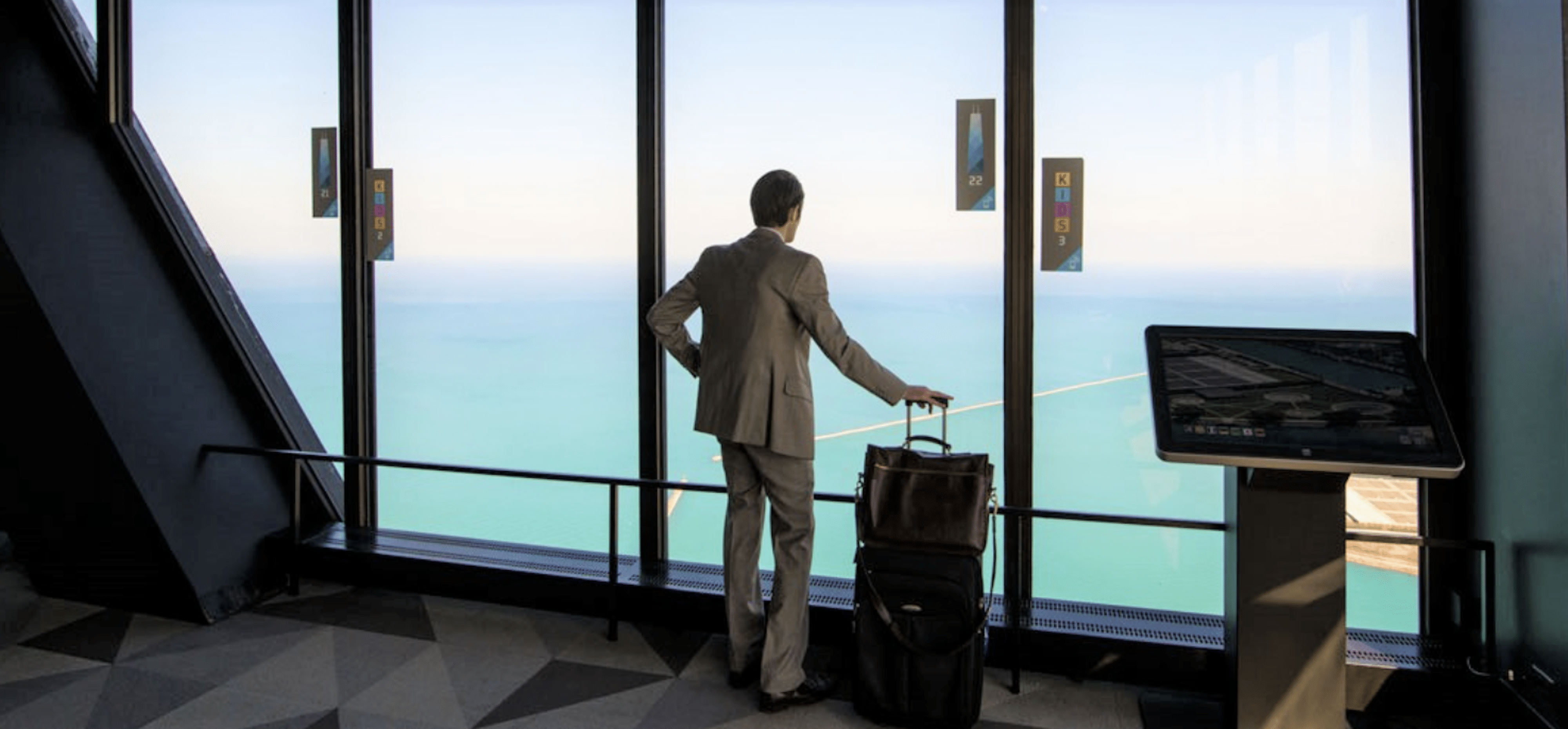[vc_row njt-role=”people-in-the-roles” njt-role-user-roles=”administrator,editor,author,armember”][vc_column][vc_column_text]
According to a Deloitte study on business travel conducted last February in the United States and Europe, this activity should return to its pre-pandemic scope, excluding inflation, at the end of 2024-beginning of 2025. But it is reborn in a different form, with a rise in smaller, connected events and an increasing focus on sustainability and cost reduction.
Although it is rebounding less quickly than leisure tourism, business travel is picking up. According to the third edition of the Deloitte business travel study, “Navigating Toward a New Normal,” we can expect its “full recovery from 2019 by late 2024 or early 2025.” For all that, “when inflation and lost earnings are factored in, the business travel market could be 10 to 20 percent lower than it was before the pandemic.”
Based on a survey of 334 U.S. and European executives responsible for overseeing the travel budget conducted between February 7 and 23, 2023, the study provides insight into “why and when employees are being asked to travel for business, as well as the dynamics that are creating headwinds and opportunities for the industry.”
And beyond the business volume aspect, the pandemic has clearly left its mark on the way companies think about business travel. Inflation, sustainability, and the rise of technology are definitely influencing their approaches.
International travel to drive recovery
The first finding is that “business travel spending in the U.S. and Europe is expected to reach more than half (according to 57% of companies surveyed) of pre-pandemic levels in the first half of 2023 and jump to 71% by year-end.” In addition, 71% of U.S. companies and 68% of European companies expect a full recovery in travel spending by the end of 2024.
International travel is expected to drive this recovery: for U.S. respondents, it is expected to represent 33% of spending in 2023, up from 21% in 2022 and similar levels to 2019.
The main objective of international travel is to re-establish a direct relationship with clients and prospects. In Europe, working on client projects, followed by sales meetings, are expected to be drivers, while in the U.S., building relationships with clients is the primary motivation for these trips, as well as connecting with global industry colleagues.
Quoted by 45% of companies in 2023 (compared to 72% in 2022) as a reason for limiting the frequency of travel, the increase in fares has less impact in 2023 on the number of trips made. However, they will be looking for cheaper accommodation (59%) or flights (56%) to reduce the cost per trip.
Smaller, connected events
Among the underlying trends, the Deloitte study highlights the rise of live events, “poised to become the main driver of business travel demand”: still the fifth most popular reason for international travel from the U.S. in 2022, they will catapult to first place in 2023.
But these events are evolving: half of the companies will “split large gatherings into smaller, regional, virtually connected events,” while “44% have adopted a hybrid approach.” In addition, the customer is a major focus at internal events: 42% of U.S. companies and 54% of European companies plan to include more customers.
Telecommuting and sustainability are also influencing some travel decisions. 33% of U.S. companies and 40% of European companies surveyed “plan to reduce travel per employee by more than 20% by 2030 to meet sustainability goals”.
According to the report, 42% of U.S. companies and 45% of European companies have a “structure in place to allocate carbon budgets to teams, along with financial budgets.”
In addition, although still in the minority, about a third of decision-makers take into account certain sustainable criteria at their suppliers when calculating the carbon footprint of a trip: 32% consider a hotel’s certifications and sustainability ratings, 31% consider an airline’s use of sustainable fuel, and 27% consider the availability of electric vehicles in a rental car fleet.
The impact of technology
Finally, the rise of technology, whose uses have been boosted by the pandemic, is having a major impact on the evolution of business travel. According to the survey, technology can “address almost every business travel need – to one degree or another.” Indeed, the rate of home-based work is expected to be 3.2 times higher than before the pandemic. As a result, for 44% of business leaders, internal training and team meetings are “considered the most replaceable by technology” compared to only 11% for “building customer relationships” and 7% for “customer acquisition.”
“As business leaders take a strategic view of their travel plans and the industry adapts to a new normality, live conferences and events in particular are proving that they can provide effective opportunities to connect in person, especially as remote and hybrid work remains a feature of the corporate world,” notes Eileen Crowley, vice president of Deloitte & Touche LLP and U.S. transportation, hospitality and services attestation leader.
Lire aussi > The global luxury travel market is expected to exceed $2.760 trillion by 2032
Photo à la Une : © Presse [/vc_column_text][/vc_column][/vc_row][vc_row njt-role=”not-logged-in”][vc_column][vc_column_text]
According to a Deloitte study on business travel conducted last February in the United States and Europe, this activity should return to its pre-pandemic scope, excluding inflation, at the end of 2024-beginning of 2025. But it is reborn in a different form, with a rise in smaller, connected events and an increasing focus on sustainability and cost reduction.
Although it is rebounding less quickly than leisure tourism, business travel is picking up. According to the third edition of the Deloitte business travel study, “Navigating Toward a New Normal,” we can expect its “full recovery from 2019 by late 2024 or early 2025.” For all that, “when inflation and lost earnings are factored in, the business travel market could be 10 to 20 percent lower than it was before the pandemic.”
Based on a survey of 334 U.S. and European executives responsible for overseeing the travel budget conducted between February 7 and 23, 2023, the study provides insight into “why and when employees are being asked to travel for business, as well as the dynamics that are creating headwinds and opportunities for the industry.”
And beyond the business volume aspect, the pandemic has clearly left its mark on the way companies think about business travel. Inflation, sustainability, and the rise of technology are definitely influencing their approaches.
International travel to drive recovery
The first finding is that “business travel spending in the U.S. and Europe is expected to reach more than half (according to 57% of companies surveyed) of pre-pandemic levels in the first half of 2023 and jump to 71% by year-end.” In addition, 71% of U.S. companies and 68% of European companies expect a full recovery in travel spending by the end of 2024.
International travel is expected to drive this recovery: for U.S. respondents, it is expected to represent 33% of spending in 2023, up from 21% in 2022 and similar levels to 2019.
The main objective of international travel is to re-establish a direct relationship with clients and prospects. In Europe, working on client projects, followed by sales meetings, are expected to be drivers, while in the U.S., building relationships with clients is the primary motivation for these trips, as well as connecting with global industry colleagues.
[…][/vc_column_text][vc_cta h2=”Cet article est réservé aux abonnés.” h2_font_container=”tag:h2|font_size:16|text_align:left” h2_use_theme_fonts=”yes” h4=”Abonnez-vous dès maintenant !” h4_font_container=”tag:h2|font_size:32|text_align:left|line_height:bas” h4_use_theme_fonts=”yes” txt_align=”center” color=”black” add_button=”right” btn_title=”JE M’ABONNE !” btn_color=”danger” btn_size=”lg” btn_align=”center” use_custom_fonts_h2=”true” use_custom_fonts_h4=”true” btn_button_block=”true” btn_custom_onclick=”true” btn_link=”url:https%3A%2F%2Fluxus-plus.com%2Fnouveaux-abonnements-et-newsletter%2F”]Accédez en illimité à tous les articles et vivez une expérience de lecture inédite, contenus en avant première, newsletter exclusives…
Déjà un compte ? Connectez-vous.[/vc_cta][vc_column_text]Photo à la Une : © Press[/vc_column_text][/vc_column][/vc_row][vc_row njt-role=”people-in-the-roles” njt-role-user-roles=”subscriber,customer”][vc_column][vc_column_text]
According to a Deloitte study on business travel conducted last February in the United States and Europe, this activity should return to its pre-pandemic scope, excluding inflation, at the end of 2024-beginning of 2025. But it is reborn in a different form, with a rise in smaller, connected events and an increasing focus on sustainability and cost reduction.
Although it is rebounding less quickly than leisure tourism, business travel is picking up. According to the third edition of the Deloitte business travel study, “Navigating Toward a New Normal,” we can expect its “full recovery from 2019 by late 2024 or early 2025.” For all that, “when inflation and lost earnings are factored in, the business travel market could be 10 to 20 percent lower than it was before the pandemic.”
Based on a survey of 334 U.S. and European executives responsible for overseeing the travel budget conducted between February 7 and 23, 2023, the study provides insight into “why and when employees are being asked to travel for business, as well as the dynamics that are creating headwinds and opportunities for the industry.”
And beyond the business volume aspect, the pandemic has clearly left its mark on the way companies think about business travel. Inflation, sustainability, and the rise of technology are definitely influencing their approaches.
International travel to drive recovery
The first finding is that “business travel spending in the U.S. and Europe is expected to reach more than half (according to 57% of companies surveyed) of pre-pandemic levels in the first half of 2023 and jump to 71% by year-end.” In addition, 71% of U.S. companies and 68% of European companies expect a full recovery in travel spending by the end of 2024.
International travel is expected to drive this recovery: for U.S. respondents, it is expected to represent 33% of spending in 2023, up from 21% in 2022 and similar levels to 2019.
The main objective of international travel is to re-establish a direct relationship with clients and prospects. In Europe, working on client projects, followed by sales meetings, are expected to be drivers, while in the U.S., building relationships with clients is the primary motivation for these trips, as well as connecting with global industry colleagues.
[…][/vc_column_text][vc_cta h2=”Cet article est réservé aux abonnés.” h2_font_container=”tag:h2|font_size:16|text_align:left” h2_use_theme_fonts=”yes” h4=”Abonnez-vous dès maintenant !” h4_font_container=”tag:h2|font_size:32|text_align:left|line_height:bas” h4_use_theme_fonts=”yes” txt_align=”center” color=”black” add_button=”right” btn_title=”JE M’ABONNE !” btn_color=”danger” btn_size=”lg” btn_align=”center” use_custom_fonts_h2=”true” use_custom_fonts_h4=”true” btn_button_block=”true” btn_custom_onclick=”true” btn_link=”url:https%3A%2F%2Fluxus-plus.com%2Fnouveaux-abonnements-et-newsletter%2F”]Accédez en illimité à tous les articles et vivez une expérience de lecture inédite, contenus en avant première, newsletter exclusives…
Déjà un compte ? Connectez-vous.[/vc_cta][vc_column_text]Photo à la Une : © Presse[/vc_column_text][/vc_column][/vc_row]








